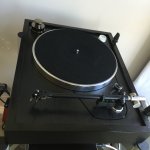15,937 posts and finally some color.
I finally was able to box them up. Separates are the way to go, I'd like to see the transformer at least 12" away.
Don't ask about the wooden panel.
Many thanks Salas, up and running and already sounding pretty damn good after 45 minutes.
Just ordered a new DMM to measure capacitors and leds which will let me tweak it in needed...
Damuffin, very neat box up. Despearce, congrats. What kind of TT equipment are you using around those builds? RCruz, you know you can't post G string videos on an audio forum! Oooops...its a cellos performance. Very nice 😀
Sounds like a very competent combo. Is that arm fuss free after setting it up and in service?
Totally, clean the carriage once in a while with isopropyl alcohol and that's it.
I have 3 spare wands so trying different cartridges is s 2 minute job.
On a different note the dip switches for loading, is that more for MM? Is it a case of just trying different options and it not being able to do any harm just change the sound?
I have 3 spare wands so trying different cartridges is s 2 minute job.
On a different note the dip switches for loading, is that more for MM? Is it a case of just trying different options and it not being able to do any harm just change the sound?
Its very helpful on MC too. Either for best loading different cartridges without soldering resistors each time or to can decide the loading of one cartridge for system synergy easier. Its not only the four fixed values, its also the combinations by paralleling two or more of them via switch on. Can be calculated or just confirmed across each input RCA with an Ohm meter when the power is off and the TT disconnected. Changing the switches on the fly is possible, only do it in very low volume.
One off Amazon, forgot the name but it's a copy of one of the Flukes, all the standard stuff plus capacitance, temperature, diode lighting, hfe and something else.
The model was VC99
The model was VC99
Proster Vici vc99 6999, I didn't want to spend a fortune and this had lots of good reviews with quite a few comparing it to the equivalent Fluke they also owned....
I know which one you mean. Don't trust it for messing with mains panels. Unsafe. For very small capacitor values accuracy you normally need a competent LCR meter. I don't know how that DMM will do in that area. At least it should be consistent in absolute error so you can match caps. An affordable meter that does quite alright in the nF scale (after using the delta button) in comparison to my DER-EE LCR is my UT61E.
It's only for the diy hifi projects (another mm stage for my son and maybe an aleph j or f6 amp and preamp)
I checked the bias after the stage had been used for 3 hours, one channel was 35.1v and 3.6v whilst the other (the one I replaced an led in) was 32.9 and 3.6 Will this cause an issue, I assume the led wasn't as well matched as I thought
Roxan Xerxes
Michell Techno Arm
Longhorned Denon DL-103
Another very nice TT. BTW you miss the PE protective earth RAW DC PCB wire to PSU chassis in that earlier FSP photo or is it done underneath the board?
Another very nice TT. BTW you miss the protective earth RAW DC PCB wire to PSU chassis in that earlier FSP photo or is it done underneath the board?
Thats a good catch. I was wondering about the PE on the supply. I put a hoop(green wire from phono) to one of the standoffs. What should be connected to protective earth?
In the other box there is a PE designated pad on the raw board between the DC OUT connectors. You put a wire there that screws somewhere at the box. Its a link to the mains earth safety and its normally kept lifted anyway by the two RAW board big diodes while there is no accidental fault.
In the phono box revise the hoop if its connecting to the PSU box also through the umbilical after you will do the PE thing. Use it only for a TT ground lug. Also use a wire from where it says GND near where it says Rail+ to a metal standoff. That will make the phono box same level with the FSP ground for best hum.
- Home
- Source & Line
- Analogue Source
- Simplistic NJFET RIAA

